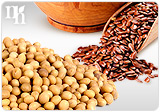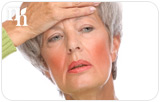Many women turn to estradiol or estrogen medications to increase their estrogen levels; however, these medications can have varying levels of effectiveness and potential side effects. Hormone therapy has become a common treatment for many symptoms of menopause, including hot flashes, vaginal dryness, and night sweats. These symptoms are often a result of the decrease in estrogen production in the body during the menopause transition. Keeping reading to find out the differences between estrogen and estradiol hormones.
What Is Estrogen?
Estrogen is a collection of hormones naturally produced by the body - primarily in the ovaries - that works together to induce female puberty, regulate menstrual cycles, and support the survival of the fetus. Estrogens also play a key role in over 300 bodily functions and have a significant impact on the following:

- Senses: vision, hearing, taste, touch, and smell
- Bone, heart, and skin health
- Sleep
- Memory
- Attention span
- Pain threshold
“Estrogen” collectively refers to of over two dozen hormones, but three of these are the most common: estrone, estradiol, and estriol. Estrogen deprivation is common in postmenopausal women and is often identified by the symptoms of hot flashes and vaginal dryness, itching, or burning. Low estrogen levels also increase the risk of osteoporosis, which is a condition where your bones grow weak and thin, causing them to break easily.
What Is Estradiol?

Estradiol is the most active form of estrogen that is released from the ovaries, adrenal glands, and the placenta (i.e., during pregnancy). The natural production of estradiol begins at the first menstrual cycle and begins to slow down approaching menopause. Estradiol estrogen is significant for the growth of the womb, fallopian tubes, and vagina, as well as for breast development and body fat distribution. Estradiol is the most powerful hormone for cell growth in breasts, with 1,000 times higher potency than estriol.
Sources of Estrogen and Estradiol
When estrogen and estradiol levels decrease, women may consider both natural and pharmaceutical treatments to balance them. It is important to consult a doctor about the methods, effectiveness, and related side effects of synthetic and natural hormones.
Natural sources

Estrogen can be consumed orally by eating phytoestrogenic foods (e.g., soy and flaxseeds), which contain plant compounds that fit in estrogen receptors and can therefore be classified as a form of estrogen. However, these foods don't help the body to produce its own hormones.
Synthetic sources
Estradiol is effective for replacing missing estradiol in the body. Estradiol is commonly used topically as a gel, spray, or an emulsion. While synthetic estrogen therapy includes a mixture of several types of estrogen, it is commonly used orally as tablets. However, any form of estrogen medication presents the risk of side effects like blood clots.
More Information
One way to potentially balance hormone levels is with natural sources of estrogen rather than taking synthetic estrogens. Synthetic hormones have been reported to increase risk of blood clots, heart attacks, strokes, breast cancer, and gallbladder disease.
The most efficient way to avoid the risks and menopause symptoms that are associated with imbalanced estrogen is to monitor estrogen levels. Learn how to test and monitor estrogen in order to determine when treatment may be needed.


